![]()
![]()
![]()
Use LEFT and RIGHT arrow keys to navigate between flashcards;
Use UP and DOWN arrow keys to flip the card;
H to show hint;
A reads text to speech;
243 Cards in this Set
- Front
- Back
|
identify the content/procedures that would require the implementation of an LOA/SOP. Write A for LOA or B for SOP in the blanks provided.
236. Establish local stripmarking procedures |
B
(LP, p. 10) |
|
|
identify the content/procedures that would require the implementation of an LOA/SOP. Write A for LOA or B for SOP in the blanks provided.
237. Delegate the responsibility for ATC services to the tower, approach control, and the ARTCC |
A
(LP, p. 5) |
|
|
238. A device that is used or intended to be used for flight in the air.
|
Aircraft
(LP, p. 5) |
|
|
239. An area of land or water that is used or intended to be used for the landing and takeoff of aircraft
|
Airport
(LP, p. 6) |
|
|
240. A service operated by appropriate authority to promote the safe,
orderly, expeditious flow of air traffic |
Air Traffic Control
(LP, p. 6) |
|
|
241. An authorization by air traffic control for the purpose of preventing collision between known aircraft, and for an aircraft to proceed under specified traffic conditions within controlled airspace.
|
Air Traffic Clearance
(LP, p. 4) |
|
|
242. Specified information relating to the intended flight of an aircraft, that is filed orally, in writing, or by
|
Flight Plan
(LP, p. 7) |
|
|
243. A level of constant atmospheric pressure related to a reference datum of 29.92 inches of mercury.
|
Flight Level
(LP, p. 7) |
|
|
244. Separation of all air traffic within designated airspace by air traffic
control. |
Positive Control
(LP, p. 7) |
|
|
245. Separation in accordance with the applicable minima in FAA Order JO 7110.65.
|
Approved Separation
(LP, p. 8) |
|
|
246. A geographical location in relation to which the position of an aircraft is reported.
|
Reporting Point
(LP, p. 7) |
|
|
247. A pilot in command may deviate from FAR 91 if ________.
A. the aircraft is within Class G airspace B. there is an emergency requiring immediate action C. the aircraft is in visual conditions D. an ATC clearance is requested |
B. there is an emergency requiring immediate action
(LP, p. 27) |
|
|
248. Which of the following Right-of-Way rules is not correct?
A. Converging aircraft, aircraft on the left has right-of-way B. Overtaking, aircraft being overtaken has right-of-way C. Head-on, both aircraft give way to the right D. Landing, aircraft on final approach has right-of-way |
A. Converging aircraft, aircraft on the left has right-of-way
(LP 10, p. 16) |
|
|
249. Pilots of two aircraft may operate as a formation flight when ________.
A. authorization is obtained from ATC B. flight visibility is at least 3 miles C. prior arrangements are made and no paying passengers are aboard D. flight is conducted at or above 1,500 feet MSL |
C. prior arrangements are made and no paying passengers are aboard
(LP, p. 14) |
|
|
250. ATC specialists who are age 40 and above shall be scheduled by facility managers for medical examinations every __________ if in the terminal/center environment.
A. 3 years B. year C. 2 years D. 6 months |
B. year
(LP 10, p. 41) |
|
|
251. The maximum speed authorized by FAR for aircraft below 10,000 feet MSL is ________ knots.
A. 250 B. 200 C. 180 D. 150 |
A. 250
(FAR, 91.117; LP, p. 19) |
|
|
252. Airspeed in a VFR corridor through Class B airspace shall not be more than ________ knots.
A. 150 B. 180 C. 200 D. 250 |
C. 200
(LP, p. 21) |
|
|
253. A pilot operating below 18,000 feet MSL shall set the altimeter to ________.
A. current altimeter setting of a station along the route and within 100 NM of the aircraft B. current altimeter setting of a station along the route and within 200 NM of the aircraft C. 29.29 in/hg D. 29.92 in/hg |
A. current altimeter setting of a station along the route and within 100 NM of the aircraft (LP, p. 25)
|
|
|
254. When operating an aircraft at an airport in Class G Airspace that has an operating control tower, unless otherwise authorized, the pilot must have ________.
A. a transponder with Mode C B. a transponder only C. radar contact and two-way communications D. two-way radio communications with the tower |
D. two-way radio communications with the tower
(LP, p. 28) |
|
|
255. The minimum age required to obtain an ATC control tower operator certificate is: ________.
A. 18 B. 21 C. 30 D. No age requirement |
A. 18
(LP, p. 38) |
|
|
256. Bernoulli’s Principle states: “The internal pressure of a fluid ________ at points where the speed of the fluid ________.”
A. increases; increases B. decreases; increases C. increases; decreases D. decreases; decreases |
B. decreases; increases
(LP, p. 3) |
|
|
257. Regarding helicopters, the cyclic controls the _______ of the rotor blades and the collective controls the _________.
A. pitch; tilt B. speed; pitch C. tilt; pitch D. angle; speed |
C. tilt; pitch
(LP 12, pp. 40 and 42) |
|
|
258. Which of the following does NOT affect aircraft performance?
A. Temperature B. Moisture C. Pressure D. Relative wind |
257. D. Relative wind
(LP 12, p. 15) |
|
|
259. A secondary form of lift is a(n) __________ generated by air striking the underside of the airfoil and being deflected __________.
A. upward force; downward B. downward force, upward C. pressure differential; over the wing D. upward force; over the wing |
258. A. upward force; downward
(LP 12, p. 5) |
|
|
260. An imaginary straight line drawn from the leading edge to the trailing edge of a cross section of an airfoil is called the _______.
A. chord line B. camber C. relative wind D. angle of attack |
A. chord line
(LP, p. 8) |
|
|
261. When ________ and ________ are in equilibrium, the aircraft neither gains nor loses airspeed.
A. thrust; drag B. lift; thrust C. lift; weight D. weight; drag |
A. thrust; drag
(LP 12, p. 14) |
|
|
262. What force in flight counteracts lift?
A. Pressure B. Thrust C. Weight D. Relative wind |
C. Weight
(LP, p. 13) |
|
|
263. What is used to determine the angle of attack?
A. Chord line and the ground B. Relative wind and chord line C. Flight path and relative wind D. Flight path and upper camber |
B. Relative wind and chord line
(LP, p. 9) |
|
|
264. If a pilot adjusts the pitch and yaw, the aircraft is moving along the ________ and __________ axes.
A. longitudinal; vertical B. lateral; vertical C. longitudinal; lateral D. lateral; horizontal |
B. lateral; vertical
(LP 12, p. 25) |
|
|
265. Relative wind flows in a direction __________ and __________ the direction of flight.
A. parallel with; opposite to B. parallel with; perpendicular to C. opposite to; perpendicular to D. opposite to; divergent from |
A. parallel with; opposite to (LP 12, p. 6)
|
|
|
266. The blades of a helicopter are shaped like ________ and act as ________.
A. airfoils; ailerons B. ailerons; elevators C. airfoils; wings D. ailerons; wings |
C. airfoils; wings
(LP 12, p. 39) |
|
|
267. Which of the following is a principal airfoil?
A. Rudder B. Propeller C. Fuselage D. Trim tabs |
B. Propeller
(LP 12, p. 7) |
|
|
268. When air density decreases what occurs?
A. Rate of climb is faster and landing speed will be faster B. Landing speed is faster and engine power output will be decreased C. Takeoff run is longer and the engine produces more power D. Rate of climb is slower and takeoff run is shorter |
B. Landing speed is faster and engine power output will be decreased
(LP 1 2, p. 21) |
|
|
269. An aircrafts movement around the longitudinal axis is controlled by the __________ and is called _________.
A. rudder; yaw B. ailerons; roll C. elevator; pitch D. ailerons; yaw |
B. ailerons; roll
(LP 12, p. 24) |
|
|
270. At approximately what angle of attack will air no longer flow smoothly over the wing’s upper surface?
A. 5-10 B. 10-15 C. 13-18 D. 15-20 |
D. 15-20
(LP, p. 45) |
|
|
271. What type of icing is an aircraft likely to encounter when flying in temperatures above freezing?
A. Pitot tube icing B. Wing icing C. Carburetor icing D. Windshield icing |
C. Carburetor icing
(LP, p. 51) |
|
|
272. What is the basic purpose of the autorotation maneuver in a helicopter?
A. Provide a controlled landing when the engine is no longer supplying power B. Conserve fuel during cruise flight C. Maintain a constant altitude D. Allow hovering flight in a strong wind |
A. Provide a controlled landing when the engine is no longer supplying power
(LP, p. 44) |
|
|
273. An aircraft with a certificated takeoff weight of more than 41,000 lbs. up to but not including 300,000 lbs. is classified as ________.
A. heavy B. large C. small D. medium |
B. large
(LP 14, p. 9) |
|
|
274. A small business jet aircraft will fall into which aircraft category?
A. Small B. Category I C. Category II D. Category III |
D. Category III
(LP, p. 4) |
|
|
275. A C17 is what type of aircraft?
A. Cessna B. Cargo C. Caravan D. Commercial |
B. Cargo
(LP 14, p. 12) |
|
|
276. Three (3) of the 6 basic tail configurations are ________.
A. conventional, forward slant and “T” B. swept, delta and straight C. horizontal stabilizer above fuselage, empennage and modified “V” D. twin boom, conventional and delta |
A. conventional, forward slant and “T”
(LP 14, p. 22) |
|
|
277. Most CAT I aircraft will generally operate within which speed range?
A. Zero–90 Knots B. 100-160 Knots C. 160-250 Knots D. 300-550 Knots |
B. 100-160 Knots
(LP, p. 5) |
|
|
278. Recognition features of the B737 are ___________.
A. One jet engine under each wing, low wing B. Two jet engines under each wing, low wing C. One jet engine under each wing, T-tail D. One jet engine under each wing, one jet in tail |
A. One jet engine under each wing, low wing
(LP 14, p. 58) |
|
|
279. Which of the following is not one of the three basic wing placements found on aircraft?
A. Tandem-wing B. High-wing C. Low-wing D. Mid-wing |
A. Tandem-wing
(LP, p. 18) |
|

280 . The following graphic depicts a/an
A. L1011. B. MD11. C. DC10. |
B. MD11.
(LP, p. 64) |
|

281 The aircraft pictured is a ________.
A. A320 B. B737 C. A306 D. B757 |
C. A306
(LP 14, p. 60) |
|
|
282. What is the prominent identification feature of the C172?
A. High-wing B. Conventional gear C. Mid-tail D. Turboprop |
A. High-wing
(LP, p. 35) |
|

283. Which of the following aircraft is depicted in this graphic?
A. Citation 550 B. Citation 10 C. Beechjet D. Golden Eagle |
A. Citation 550
(LP 14, p. 48) |
|
|
284. An aircraft weighing 300,000 pounds will fall into the ________ weight class.
A. Small B. Medium C. Large D. Heavy |
D. Heavy
(LP 14, p. 9) |
|
|
285. Name four aircraft identification features.
_____________________ _____________________ _____________________ _____________________ |
Size, engine location and number, engine type, wing placement, wing configuration, tail configuration, windows, fuselage shape, and landing gear.
(LP, p. 16) |
|
|
286. Low altitude RNAV route 12 is spoken:
A. “Q twelve” B. “Quebec twelve” C. “T twelve” D . “Tango twelve” |
D . “Tango twelve”
(LP 16, p. 37) |
|
|
287. The different classes of VORs are ________.
A. High, Low, Terminal B. High, Medium, Low C. High, Low, Compass Locator D. High, Medium, Terminal |
A. High, Low, Terminal
(LP, p. 7) |
|
|
288. The bearing and DME frequencies of a TACAN are paired and assigned by ________ numbers.
A. course B. radial C. channel D. heading |
C. channel
(LP 16, p. 11) |
|
|
289. Generally, the vertical dimensions of a low altitude VOR airway are from ________.
A. the surface up to but not including 18,000 feet AGL B. the surface up to but not including 18,000 feet MSL C. 12,000 feet AGL up to, but not including 18,000 feet MSL D. 1,200 feet AGL up to, but not including, 18,000 feet MSL |
D. 1,200 feet AGL up to, but not including, 18,000 feet MSL (LP, p. 33)
|
|
|
290. The non-radar lateral protected airspace of a victor airway within 51NM of the NAVAID is ________.
A. 8 NM either side of centerline B. 4 NM either side of centerline C. 10 NM either side of centerline D. 20 NM either side of centerline |
B. 4 NM either side of centerline
(LP, p. 34) |
|
|
291. The component of the ILS which gives lateral course guidance to the runway is the ________.
A. localizer B. marker beacon C. glide slope D. DME |
A. localizer
(LP, p. 17) |
|
|
292. Which is not a characteristic of a Nondirectional Radio Beacon (NDB)?
A. More accurate than a VOR B. Provides a bearing to be flown during an approach C. Adversely affected by lightning D. Used to establish nonprecision approaches |
A. More accurate than a VOR (LP 16, p.4)
|
|
|
293. The GPS receiver needs at least ________ satellites to yield three-dimensional information, including position, velocity, time, and altitude.
A. 3 B. 4 C. 5 D. 6 |
B. 4
(LP, p. 26) |
|
|
294. The difference between DME slant-range and actual horizontal distance is greatest ________.
A. at low altitude close to the NAVAID B. at high altitude far from the NAVAID C. at low altitude far from the NAVAID D. at high altitude close to the NAVAID |
D. at high altitude close to the NAVAID
(LP, p. 12) |
|
|
295. An Non Directional Beacon (NDB) used in conjunction with the Instrument Landing System (ILS) is called a(n) ________.
A. compass locator B. marker beacon C. Outer Marker (OM) D. Automatic Direction Finder (ADF) |
A. compass locator
(LP, p. 4) |
|
|
296. When NO MEA is depicted, the MEA on a jet route is _______ feet MSL.
A. 14,500 B. 18,000 C. 24,000 D. 45,000 |
B. 18,000
(LP, p. 40) |
|
|
297. Which chart furnishes terminal data for IFR flight in congested areas?
A. IFR Area Charts B. Terminal Area Charts C. Airport/Facility Directory D. En Route Low Altitude Charts |
A. IFR Area Charts
(LP 18, p. 45) |
|
|
298. Which chart(s) depict ATIS frequencies where ATIS is available?
A. En Route Low Altitude Chart B. En Route High Altitude Chart C. IFR Area Chart D. Both A and C |
D. Both A and C
(LP, pp. 12, 45) |
|
|
299. Which of the following is a requirement for an airport to be published on the IFR EnRoute High Altitude Chart?
A. Has a published instrument approach. B. Has a 5000’ or greater hard surfaced runway. C. Has an operational ATCT D. Is public use. |
B. Has a 5000’ or greater hard surfaced runway.
(LP 18, p. 40) |
|
|
300. If NO changeover point is depicted along an airway, it means that ________.
A. the airway segment crosses through uncontrolled airspace B. either NAVAID can be used for the entire length of the route segment C. there is a gap in NAVAID signal coverage along the airway D. the changeover is to be made at the halfway point between the two NAVAIDs |
D. the changeover is to be made at the halfway point between the two NAVAIDs (LP, p. 19)
|
|
|
301. How is Class A airspace depicted on an En Route High Altitude Chart?
A. As a shaded brown area B. In blue, with a solid blue border C. With a hatched blue line around the boundary D. Open white area |
D. Open white area
(LP, p. 43) |
|
|
302. On an En Route Low Altitude chart, prohibited, restricted, and warning areas are shown within ________ boundaries.
A. solid grey B. blue hatched C. light brown D. solid magenta |
B. blue hatched
(LP 18, p. 27) |
|
|
303. Chart(s) that are specifically designed to provide aeronautical information used during instrument flight
A. En Route Low Charts B. En Route High Charts C. IFR Area Charts D. All of the above |
D. All of the above
(LP) |
|
|
304. En Route Low Altitude Charts are published every ________.
A. 56 days B. 112 days C. 3 months D. 6 months |
A. 56 days
(LP 18, p. 3) |
|
|
305. _______ approaches utilize WAAS and/or LAAS for course guidance.
A. RNAV B. ILS C. Localizer D. TACAN |
A. RNAV
(LP 20, p. 11) |
|
|
306. A Nonprecision approach does not provide ________.
A. electronic glide slope information B. azimuth guidance to Category D aircraft C. height and visibility minima D. missed approach instructions |
A. electronic glide slope information
(LP, p. 8) |
|
|
307. The basic marker beacons normally associated with an ILS approach are ________.
A. outer and locator B. inner and outer C. middle and inner D. outer and middle |
D. outer and middle
(LP 20, p. 9) |
|
|
308. The four segments of an IAP, in the order flown, are: Initial, Intermediate, _______, and ______.
A. Missed; Final B. Final; Outbound C. Inbound; Final D. Final; Missed |
D. Final; Missed
(LP 20, p. 5) |
|

309. In the chart, the number 6600 depicts the ________ altitude.
A. decision height B. minimum glideslope intercept C. minimum descent D. procedure turn |
B. minimum glideslope intercept
(LP 20, p. 26) |
|
|
310. Which of the following items is not found on the planview section of the IAP Chart?
A. Airport Lat./Long. Coordinates B. Initial Approach Fix C. Transition Routes D. Obstructions |
A. Airport Lat./Long. Coordinates
(LP 20, p. 20) |
|
|
311. Height of obstructions depicted on Instrument Approach Procedure Charts are _______.
A. always AGL B. found only in the Planview section C. sometimes AGL D. always MSL |
D. always MSL
(LP, p. 20, 24) |
|
|
312. A Localizer approach differs from an ILS approach because ________.
A. a localizer’s decision height is always higher than that of an ILS B. lateral course guidance is provided by a VOR signal C. localizer approaches can not provide straight-in minimums D. no electronic altitude guidance is provided |
D. no electronic altitude guidance is provided
(LP, p. 9) |
|
|
313. Which statement is true regarding Minimum Safe Altitudes (MSAs)?
A. MSAs provide obstacle clearance within 22 nautical miles of the primary approach NAVAID. B. NAVAID frequency reception is ensured at the MSA. C. Individual MSAs are depicted along each segment of the approach procedure. D. MSAs provide 1,000-foot obstacle clearance. |
D. MSAs provide 1,000-foot obstacle clearance.
(LP, p. 22) |
|
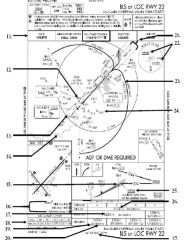
314. The intermediate segment of an approach procedure ends at the _________.
A. final approach fix B. initial approach fix C. missed approach point D. runway |
A. final approach fix
(LP, p. 6) |
|
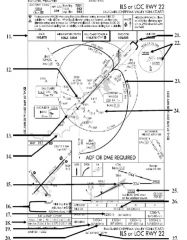
315. 11.
|
Frequency Information
|
|

316. 12.
|
EAU VORTAC
|
|
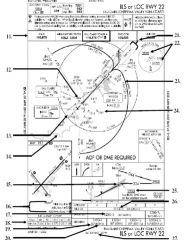
317. 13.
|
Missed Approach Track
|
|

318. 14.
|
River
|
|

319. 15.
|
Nonprecision (Localizer) Final Approach Fix
|
|
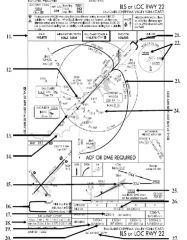
320.16.
|
Runway Lighting Aids
|
|

321. 17.
|
Minimum Descent Altitude
|
|
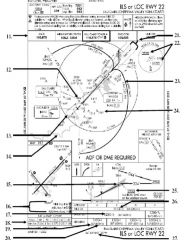
322. 18.
|
Time/Speed Table
|
|

323. 19.
|
Height Above Airport
|
|

324. 20
|
Military Minimums
|
|

325. 21.
|
Localizer
|
|

326. 22.
|
Minimum Safe Altitudes
|
|

327. 23.
|
DME Arc
|
|
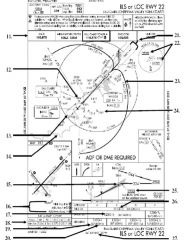
328. 24.
|
Obstruction
|
|

329. 25.
|
Minimum Glide slope Intercept Altitude
|
|

330. 26.
|
Decision Altitude
|
|
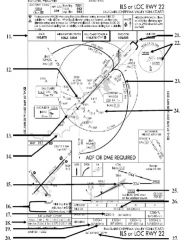
331. 27.
|
Airport Coordinates
|
|
|
332. An aircraft threatened by serious and/or imminent danger which requires immediate assistance is considered as a/an ________ condition.
A. urgent B. distress C. concerned D. lost |
B. distress
(LP, p. 4) |
|
|
333. If you are in contact with an aircraft with a suspected bomb threat, what action should you not take?
A. Comply with the pilots requests B. Handle the aircraft as an emergency C. Suggest actions for the pilot to take D. Provide the most expeditious handling possible |
C. Suggest actions for the pilot to take
(LP 22, p. 18) |
|
|
334. A pilot of an aircraft experiencing radio failure can be expected to squawk ________.
A. 7300 B. 7500 C. 7600 D. 7700 |
C. 7600
(LP 22, p. 16) |
|
|
335. Fuel remaining is expressed in _________.
A. time B. pounds C. gallons D. nautical miles |
A. time
(LP 22, p. 9) |
|
|
335. Fuel remaining is expressed in _________.
A. time B. pounds C. gallons D. nautical miles |
A. time
(LP 22, p. 9) |
|
|
336. Because specific procedures are not prescribed for every emergency situation, air traffic control personnel must ________.
A. pursue a course of action which appears to be most appropriate under the circumstances B. receive the supervisor’s approval before decisive action is taken C. make an entry in the facility log D. notify the pilot’s point of departure as soon as an emergency is declared |
A. pursue a course of action which appears to be most appropriate under the circumstances
(LP 22, p. 3) |
|
|
336. Because specific procedures are not prescribed for every emergency situation, air traffic control personnel must ________.
A. pursue a course of action which appears to be most appropriate under the circumstances B. receive the supervisor’s approval before decisive action is taken C. make an entry in the facility log D. notify the pilot’s point of departure as soon as an emergency is declared |
A. pursue a course of action which appears to be most appropriate under the circumstances
(LP 22, p. 3) |
|
|
337. Which facility is responsible for receiving and relaying all pertinent ELT signal information to the appropriate authorities?
A. AFSS B. ARTCC C. RCC D. ATCT |
B. ARTCC
(LP, p. 14) |
|
|
337. Which facility is responsible for receiving and relaying all pertinent ELT signal information to the appropriate authorities?
A. AFSS B. ARTCC C. RCC D. ATCT |
B. ARTCC
(LP, p. 14) |
|
|
338. Which of the following refers to a condition of being concerned about safety and of requiring timely, but not immediate assistance?
A. Flight assistance B. Distress C. Routine emergency D. Urgency |
D. Urgency
(LP 22, p. 5) |
|
|
339. What National Weather Service office provides meteorological forecasts, and advice to ARTCCs and other FAA facilities regarding weather impact on their missions?
A. Center Weather Service Unit (CWSU) B. Weather Forecast Office (WFO) C. Meteorological Watch Office (MWO) D. Aviation Weather Center (AWC) |
A. Center Weather Service Unit (CWSU)
(LP 24, p. 41) |
|
|
340. Within which layer of the atmosphere does temperature increase with altitude, making it a stable layer, generally devoid of significant weather?
A. Tropopause B. Troposphere C. Stratosphere D. Mesosphere |
C. Stratosphere
(LP, p. 5) |
|
|
341. Precipitation formation requires water vapor, lift, and ________.
A. a growth process B. frontal pressure C. a stable temperature D. a steep pressure gradient |
A. a growth process
(LP 24, p. 31) |
|
|
342. What type of air mass produces stable air that is associated with smooth air, poor visibility, and stratiform clouds?
A. A warm air mass moving over a cold surface B. A cold air mass moving over a warm surface C. Any warm air mass D. Any cold air mass |
A. A warm air mass moving over a cold surface
(LP 24, p. 23) |
|
|
343. Which gas constitutes only a small percentage of the earth’s atmosphere and varies widely in both time and space, ranging from trace amounts to 4 percent by volume?
A. Oxygen B. Carbon Monoxide C. Carbon Dioxide D. Water vapor |
D. Water vapor
(LP, p. 9) If asked, Oxygen is appx. 20%, CO .00001%, CO2 .039% |
|
|
344. Virtually all aircraft fly in which two layers of the atmosphere?
A. Mesosphere and stratosphere B. Troposphere and mesosphere C. Thermosphere and stratosphere D. Troposphere and stratosphere |
D. Troposphere and stratosphere
(LP 24, p. 4) |
|
|
345. When the ________ is greater than zero, the air is unsaturated.
A. condensation point B. temperature-dew point spread C. temperature D. dew point |
B. temperature-dew point spread
(LP, p. 11) |
|
|
346. A sinking parcel of air compresses and ________ as it encounters increasing pressure; this causes a cloud to quickly ________.
A. warms, form B. warms, dissipate C. cools, form D. cools, dissipate |
B. warms, dissipate
(LP, p. 16) |
|
|
347. What type of clouds look like fluffy cotton balls or heaps, indicate upward vertical motion or thermal uplift of air, and can produce severe turbulence, icing, and other hazards?
A. Cirriform B. Nimboform C. Cumuliform D. Stratiform |
Cumuliform
|
|
|
348. Air flow around a high diverges in a ________ motion and ________, causing the air to compress and warm, which tends to dissipate clouds.
A. clockwise, rises B. clockwise, sinks C. counterclockwise, rises D. counterclockwise, sinks |
B. clockwise, sinks
(LP, p. 19) |
|
|
349. Standard atmosphere is NOT used for ________.
A. pressure altimeter calibrations B. aircraft performance calculations C. weather observations D. aircraft design |
C. weather observations
(LP 24, p. 6) |
|
|
350. The ratio of water vapor in the air compared to the amount of water vapor the air can hold at a particular temperature and pressure is the definition of _________.
A. barometric surface pressure B. relative humidity C. dew point D. saturated air |
B. relative humidity
(LP 24, p. 10) |
|
|
351. Which front is associated with poor visibility, smooth air, and steady precipitation?
A. Warm B. Occluded C. Cold D. Stationary |
A. Warm
|
|
|
352. What type of precipitation occurs when there is a shallow layer aloft with above freezing temperatures, with a deep layer of below freezing air based at the surface?
A. Rain B. Snow C. Ice pellets D. Freezing rain |
C. Ice pellets
|
|
|
353. Gusty wind is coded as a ________ in the wind group of a METAR.
A. GW B. W C. WG D. G |
D. G
|
|
|
354. In the contiguous United States of America region, the ICAO Station Identifier prefix is ________.
A. PA B. P C. KA D. K |
D. K
|
|
|
355. “A scheduled report transmitted at fixed intervals” describes a ________.
A. METAR B. SPECI C. TAF D. UUA |
A. METAR
|
|
|
356. In the date/time field of a METAR, ________.
A. the first two digits are the date, the second two digits are the hour, and the last two digits are the minutes in UTC B. the six digits represent the hour, minutes, and seconds of the observation in UTC C. the first two digits are the date, the second two digits are the hour, and the last two digits are the minutes in local time D. the six digits represent the hour, minutes, and seconds of the observation in local time |
A. the first two digits are the date, the second two digits are the hour, and the last two digits are the minutes in UTC
|
|
|
357. A sky coverage of six-eighths is reported as ________.
A. BKN B. FEW C. SCT D. SKC |
A. BKN
|
|
|
358. What term refers to the greatest distance that can be seen throughout at least half the horizon circle (180 degrees), not necessarily continuous?
A. Runway Visual Range (RVR) B. Sector visibility C. Tower visibility D. Prevailing visibility |
D. Prevailing visibility
|
|
|
359. What is an instrumentally derived value that represents the horizontal distance a pilot may see down the runway from the approach end?
A. Runway Visual Range (RVR) B. Sector visibility C. Tower visibility D. Prevailing Visibility |
A. Runway Visual Range (RVR)
|
|
|
360. In the METAR/SPECI Sky Condition Group, heights are reported in ________.
A. hundreds of feet AGL B. thousands of feet AGL C. hundreds of feet MSL D. thousands of feet MSL |
A. hundreds of feet AGL
|
|
|
361. In a METAR/SPECI report, what do temperatures and dew points prefixed with an “M” signify?
A. Missing B. Below zero C. ”more than” D. Degrees Fahrenheit |
B. Below zero
|
|
|
362. SPECI KHYS 092338Z AUTO…
A. “Hays, automated, special report, three eight observation…” B. “Hays, special report, automated, two three three eight observation…” C. “Hays, special report, automated two three three eight zulu observation…” D. “Special report, Hays, two three three eight zulu observation, automated…” |
A. “Hays, automated, special report, three eight observation…”
|
|
|
363. Based on the following METAR, the visibility is ________. KOKC 181456Z 01010KT 10SM FEW055 BKN100 04/M02 A2992 RMK AO2 SLP070
A. 4 statute miles B. 10 nautical miles C. 10 statute miles D. missing |
C. 10 statute miles
|
|
|
364. R17/M0600FT
A. “Runway one seven R-V-R less than six hundred” B. “Runway one seven visual range more than six hundred feet” C. “R-V-R runway one seven below six hundred” D. “R-V-R runway one seven less than six hundred feet” |
A. “Runway one seven R-V-R less than six hundred”
|
|
|
365. SCT00 BKN080 OVC120
A. “Scattered three thousand, ceiling broken eight hundred, overcast one two thousand” B. “Scattered three thousand, broken eight hundred, ceiling one two thousand overcast” C. “Three thousand scattered, ceiling eight thousand broken, one two thousand overcast” D. “Three thousand scattered, eight thousand broken, ceiling one thousand two hundred overcast” |
C. “Three thousand scattered, ceiling eight thousand broken, one two thousand overcast”
|
|
|
366. PK WND 23034/43
A. “Peak wind two three zero at three four happened at four three zulu” B. “Peak wind two three zero at three four occurred at four three past the hour” C. “Peak wind two three zero degrees at three four knots occurred at four three zulu” D. “Peak wind two hundred thirty degrees at thirty-four knots occurred at forty-three zulu” |
B. “Peak wind two three zero at three four occurred at four three past the hour”
|
|
|
367. CIG 005V008
A. “Ceiling five hundred variable eight hundred” B. “Ceiling five hundred feet variable eight hundred feet“ C. Ceiling variable between five hundred and eight hundred” D. “Ceiling variable between five hundred feet and eight hundred feet” |
C. Ceiling variable between five hundred and eight hundred”
|
|
|
368. The purpose of a Pilot Weather Report (PIREP) is ________.
A. to report a pilot’s position B. to report meteorological conditions in flight C. to report a pilot incident D. a pilot’s report of an accident |
B. to report meteorological conditions in flight
|
|
|
369. PIREPs are used by ________ to expedite the traffic flow in the vicinity of an airport.
A. the National Weather Service B. Flight Service Stations C. centers D. towers and TRACONs |
D. towers and TRACONs
|
|
|
370. Air traffic facilities must solicit PIREPs when ________ is reported.
A. light turbulence B. visibility of 5 miles or less C. a ceiling at or below 10,000 feet D. icing of trace or greater intensity |
B. visibility of 5 miles or less
|
|
|
371. Each PIREP must include the type of aircraft, altitude, location, and ________.
A. coordinated universal time B. the temperature in degrees Celsius C. remarks D. local time |
A. coordinated universal time
|
|
|
372. When preparing PIREPs involving turbulence or icing, ________ shall always be included.
A. Sky condition B. Visibility C. Intensity D. Wind |
C. Intensity
|
|
|
373. The following PIREP indicates the base of the second cloud layer is ________.
UA/OV MKC-JOT/TM 1100/FL080/TP C182/SK BKN025-TOP045/OVC050-TOP075/WX FV99/TA08 A. 5,000 feet AGL B. 4,500 feet MSL C. 7,500 feet AGL D. 5,000 feet MSL |
D. 5,000 feet MSL
|
|
|
OKC UA /OV OKC180010/TM 1516/FL120/TP TA20/SK 035 BKN 075/OVC095-TOPUNKN/WX FV01SM SN/TA M04/TB MOD 050-070/RM TCU W DURC
374. At what altitude(s) did the aircraft first encounter turbulence? A. unknown B. 3,500-7,500 feet C. 5,000 feet D. 12,000 feet |
C. 5,000 feet
|
|
|
OKC UA /OV OKC180010/TM 1516/FL120/TP TA20/SK 035 BKN 075/OVC095-TOPUNKN/WX FV01SM SN/TA M04/TB MOD 050-070/RM TCU W DURC
375. What is the type of aircraft that made this report? A. FV01 B. TA20 C. TA04 D. TM1516 |
B. TA20
|
|
|
OKC UA /OV OKC180010/TM 1516/FL120/TP TA20/SK 035 BKN 075/OVC095-TOPUNKN/WX FV01SM SN/TA M04/TB MOD 050-070/RM TCU W DURC
376. What is the height of the base of the second layer? A. Not reported B. 3,500 feet C. 7,500 feet D. 9,500 feet |
D. 9,500 feet
|
|
|
OKC UA /OV OKC180010/TM 1516/FL120/TP TA20/SK 035 BKN 075/OVC095-TOPUNKN/WX FV01SM SN/TA M04/TB MOD 050-070/RM TCU W DURC
377. What was the weather element that caused the reduction in visibility? A. RN B. SHRA C. SN D. GR |
C. SN
|
|
|
378. After departing OKC at 0455Z, SWA5325, B737-700, 20 miles northwest of OKC climbing through 15,300 feet, reported bases 2,700, still IMC. Light turbulence was reported during the climb from 1,500 to 3,000, negative ice, wind 310 at 28
Record the intensity of the turbulence and the altitude at which it was first encountered? A. LGT/15 B. LGT 1.5 C. LGT 150 D. LGT 015 |
D. LGT 015
|
|
|
379. After departing OKC at 0455Z, SWA5325, B737-700, 20 miles northwest of OKC climbing through 15,300 feet, reported bases 2,700, still IMC. Light turbulence was reported during the climb from 1,500 to 3,000, negative ice, wind 310 at 28 377. What should be recorded in the remarks?
A. WND 31028KT B. NEG ICE C. DURC D. OKC315020 |
C. DURC
|
|
|
380. Authorized symbols and abbreviations must be used for recording ________.
A. TCAS RAs when voice recorders are operational B. relief briefings C. clearances, requests and advisories D. clearances, reports and instructions |
D. clearances, reports and instructions
|
|
|
381. The letters “OTP” on a strip stand for _______.
A. VFR conditions-on-top B. oceanic transfer point C. procedure turn D. out of control area |
A. VFR conditions-on-top
|
|
|
382. What symbol indicates that an aircraft’s clearance is void if not airborne by a specific time?
A. V= B. ~V C. V < D. V |
C. V <
|
|
|
383. What symbol should be used to delete any unwanted or unused altitude information?
A. X B. − C. + D. / |
A. X
|
|
|
384. Flight progress strips are used for _______.
A. traffic count only B. traffic sequencing only C. posting current data on air traffic D. traffic metering |
C. posting current data on air traffic
|
|
|
385. Flight progress strips are considered ________ documents.
A. outdated B. necessary C. legal D. current |
C. legal
|
|
|
386. When used on a strip, “VA” indicates which of the following?
A. Volcanic Ash B. Variable Altitude C. Visual Approach D. Virginia |
C. Visual Approach
|
|
|
387. Which of the following is the correct format to record a block altitude?
A. 100B120 B. 210/230 C. 230B210 D. B150/170 |
A. 100B120
|
|
|
388. Flight progress strips that are hand printed must ________.
A. use standard characters B. be legible C. conform to the machine printed format D. all the above |
D. all the above
|
|

En Route Strip
389. On all en route strips, Block 5 is used for what purpose? A. Aircraft ID B. Equipment suffix C. Aircraft type D. Filed true airspeed |
D. Filed true airspeed
This card is incomplete |
|
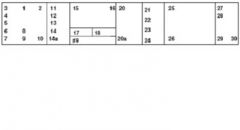
390. For en route strips, altitude information is found in which block?
A. 8 B. 27 C. 16 D. 20 |
D. 20
|
|

391. On an en route strip, in which block is the aircraft identification located?
A. 1 B. 2 C. 3 D. 4 |
C. 3
|
|

392. On an en route strip, which block contains the center-estimated time over the fix?
A. 11 B. 15 C. 19 D. 25 |
B. 15
|
|
|
393. Which control symbol(s) indicates that an ARTCC has forwarded flight plan information?
A. Slash B. Horizontal line C. Check mark D. Red circle |
D. Red circle
|
|

Terminal Strip
394. On all terminal strips, Block 5 is used for what purpose? A. Aircraft ID B. Aircraft type C. Computer ID D. Beacon code |
D. Beacon code
This question is incomplete |
|
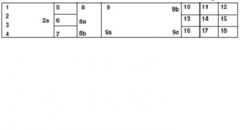
395. For terminal arrival strips, altitude information is found in which block?
A. 6 B. 7 C. 8 D. 9 |
D. 9
This question is incomplete |
|

396. On a terminal strip, in which block is the aircraft identification located?
A. 10 B. 7 C. 1 D. 2 |
C. 1
This question is incomplete |
|

397. On a terminal strip, which block contains the estimated time of arrival over a coordination fix?
A.3 B. 8 C. 18 D. 10 |
B. 8
|
|
|
398. How is a terminal strip marked to indicate that the aircraft has an emergency?
A. Black “E” B. ”EMRG” C. Red check mark D. Red ‘E” |
D. Red ‘E”
|
|
|
399. When used in FAA Orders JO 7110.10, JO 7110.65, and JO 7210.3, the word “should” means that the procedure is ________.
A. recommended B. optional C. approved D. mandatory . |
A. recommended
|
|
|
400. Letters of Agreement (LOA) are for ________ use and Standard Operating Procedures (SOPs) are for ________ use.
A. intrafacility; extrafacility B. interfacility; intrafacility C. extrafacility; jurisdictional D. intrafacility; interfacility |
B. interfacility; intrafacility
|
|
|
401. Which of the following statements about the NAS is FALSE ?
A. NextGen is the NAS modernization program. B. The NAS is entirely owned and operated by the FAA ( C. The NAS is continuously evolving. D. The NAS includes ATCS, NAVAIDS, and FARs |
B. The NAS is entirely owned and operated by the FAA
|
|
|
402. What information is contained in the FAA Order JO 7340.2?
A. Prescribes air traffic procedures and phraseology used by Flight Service specialists B. Prescribes air traffic procedures and phraseology used by air traffic controllers C. Provides direction and guidance for operating and managing Air Traffic facilities D. Contains approved words and phrase contractions used by the FAA |
D. Contains approved words and phrase contractions used by the FAA
|
|
|
403. Positive control is the ________ of all air traffic within designated airspace by ATC.
A. separation B. observation C. deviation D. sequencing |
A. separation
|
|
|
404. An ARTCC/TRACON is divided into areas of control jurisdiction called ________.
A. positions B. regions C. sectors D. sections |
C. sectors
|
|
|
405. In an ATCT, which 3 positions communicate directly with the pilots?
A. Flight Data, Local and Ground B. Local, Clearance Delivery, and Tower Coordinator C. Ground, Local and Clearance Delivery D. Local, Tower Coordinator, and Flight Data |
C. Ground, Local and Clearance Delivery
|
|
|
406. Traffic management programs are one of several processes administered by the Air Traffic Control System Command Center (ATCSCC) to achieve optimum use of the ________ and minimize ________ without increasing controller workload.
A. airspace, accidents B. NAS, delays C. ATC System, accidents D. airports, delays |
B. NAS, delays
|
|
|
407. Which document lists location identifiers authorized by the FAA?
A. FAA Order JO 7340.2 B. FAA Order JO 7110.65 C. Aeronautical Information Manual D. FAA Order JO 7350.8 |
D. FAA Order JO 7350.8
|
|
|
408. Considering the operational priorities of an air traffic controller, ________ have priority over ________ aircraft.
A. VFR/IFR B. aircraft in distress/lifeguard C. presidential/lifeguard D. diverted/aircraft in distress |
B. aircraft in distress/lifeguard
|
|
|
409. “Automation procedures are used in preference to non-automation procedures” is an example of ATC:
A. Duty Priority B. Procedural Preference C. Operational Priority D. Primary Purpose |
B. Procedural Preference
|
|
|
410. The correct designation for a runway with a magnetic heading of 009 degrees is runway ________.
A. 9 B. 1 C. 01 D. 10 |
B. 1
|
|
|
411. Which of the following is not one of the uses of a movement area?
A. Air taxiing B. Hover taxiing C. Loading passengers D. Takeoff and landing of aircraft |
C. Loading passengers
|
|
|
412. Which of the following statements about airport beacons is FALSE?
A. They are turned on at night B. They are turned on during restricted weather C. They are turned on whenever the tower is operational D. They identify the type of airport |
C. They are turned on whenever the tower is operational
|
|
|
413. At an airport with no precision approach procedures, which of the following runway markings will NOT be present?
A. Touchdown zone B. Runway designator C. Runway centerline D. Aiming point |
A. Touchdown zone
|
|
|
414. “Separating aircraft and issuing safety alerts” represents an air traffic controller’s first ________.
A. Duty Priority B. Procedural Preference C. Operational Priority D. Primary Purpose |
A. Duty Priority
|
|
|
415. The addition, deletion, or modification of information or instructions within an order are made through a(n) ________.
A. change B. notice C. supplement D. amendment |
A. change
|
|
|
416. RVSM stands for ________
A. Required Visual Separation Minima B. Reduced Vertical Separation Minima C. Requested Visual Separation Minima D. Required Vertical Separation Minima |
B. Reduced Vertical Separation Minima
|
|
|
417. Minimum vertical separation between RVSM equipped IFR aircraft up to and including FL410 is ________ feet.
A. 1,000 B. 5,000 C. 4,000 D. 2,000 |
A. 1,000
|
|
|
418. Which of the following is not a method for establishing non-radar longitudinal separation?
A. Depart at a specified time B. Arrive at a fix at a specified time C. Clear aircraft to fly on airways which do not overlap D. Hold at a fix until a specified time |
C. Clear aircraft to fly on airways which do not overlap
|
|
|
419. When using non-radar departure divergence ___________.
A. the airport must have at least 2 runways that intersect B. the ATCS must wait 10 minutes between successive departures C. the ATCS must ensure visual separation exists D. the ATCS must assign courses that diverge by at least 45 degrees |
D. the ATCS must assign courses that diverge by at least 45 degrees
|
|
|
420. When using visual separation, what are the separation minima?
A. 5NM B. 1,000 feet C. 10 minutes D. There are no specified minima. |
D. There are no specified minima.
|
|
|
421. The minimum terminal radar separation for two IFR aircraft less than 40 miles from the antenna is ________ miles.
A. 3 B. 10 C. 5 D. 20 |
A. 3
|
|
|
422. A nonstandard holding pattern ________.
A. has leg lengths which must be measured in minutes B. is one that is located at a navigational aid C. uses left turns D. uses right turns |
C. uses left turns
|
|
|
423. Runway separation is applied by ________ controllers.
A. Air Route Traffic Control Center (ARTCC) B. Air Traffic Control Tower (ATCT) C. Terminal Radar Approach Control (TRACON) D. Automated Flight Service Station (AFSS) |
B. Air Traffic Control Tower (ATCT)
|
|
|
424. Who is responsible for observing and reporting the conditions of the landing area of an airport?
A. Airport manager/operator B. Tower controller C. Pilot D. Flight service specialist |
A. Airport manager/operator
|
|
|
425. What type of NOTAM consists of information that is regulatory in nature, pertaining to flight, including but not limited to changes to IFR charts, procedures, and airspace usage?
A. NOTAM D B. FDC NOTAM C. Military NOTAM D. Pointer NOTAM |
B. FDC NOTAM
|
|
|
426. A feature which improves a primary radar display is:
A. Moving target indicator B. Anomalous propagation C. Temperature inversion D. Ring around |
A. Moving target indicator
|
|
|
427. Which radar system relies on reflected radio signals and does NOT require equipment in aircraft?
A. Primary radar B. Secondary radar C. Airport radar D. Positive radar |
A. Primary radar
|
|
|
428. Which of the following is a component of a secondary radar system?
A. Moving Target Indicator B. Circular polarization C. Receiver D. Transponder |
D. Transponder
|
|
|
429. An advantage of secondary radar over primary radar is it's ______.
A. longer range B. ability to switch from linear polarization to circular polarization C. improved weather display D. display of any object which reflects radio energy |
A. longer range
|
|
|
430. Which document provides direction and guidance for operating and managing Air Traffic facilities?
A. FAA Order JO 7110.10 B. FAA Order JO 7210.3 C. Aeronautical Information Manual D. Terminal Phraseology Guide |
B. FAA Order JO 7210.3
|
|
|
431. Which document prescribes air traffic procedures and phraseology used by Flight Service specialists?
A. FAA Order JO 7210.3 B. FAA Order JO 7110.10 C. Aeronautical Information Manual D. FAA Order JO 7110.65 |
B. FAA Order JO 7110.10
|
|
|
432. Advising the En Route Radar and Radar Associate positions of sector actions required to accomplish the safe and efficient operation of the sector is a responsibility of the En Route ________ position.
A. radar coordinator/handoff B. radar flight data C. clearance delivery D. traffic management |
A. radar coordinator/handoff
|
|
|
433. Which AFSS position uses the radio call sign "Flight Watch"
A. EFAS B. Inflight C. Broadcast D. Preflight |
A. EFAS
|
|
|
434. Airmen’s information can be disseminated via Aeronautical Charts and _______.
A. satellite communications B. facility directives C. flight information publications D. FAA orders |
C. flight information publications
|
|
|
435. Which document contains items concerning pilot’s health and medical facts, factors affecting flight safety, and accident reporting?
A. FAA Order JO 7110.10 B. FAA Order JO 7210.3 C. Aeronautical Information Manual D. Terminal Phraseology Guide |
C. Aeronautical Information Manual
|
|
|
436. The purpose of a “Supplement” is ________.
A. temporary direction for a situation requiring immediate action B. to add, delete, or modify information or instructions within an order C. to make one-time announcements D. to consolidate instructions from different levels into a single directive |
D. to consolidate instructions from different levels into a single directive
|
|
|
437. Which of the following is an example of a temporary directive?
A. Supplements B. LOA C. GENOT D. Orders |
C. GENOT
|
|
|
438. Taxiway centerline lights emit ______.
A. steady green lights B. flashing green lights C. alternating green and blue lights D. steady blue lights |
A. steady green lights (LP 3, p. 33)
|
|
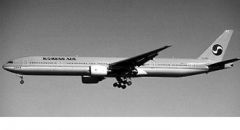
439. What aircraft is pictured above?
A. B737 B. B757 C. A300 D. B777 |
D. B777
(LP 14, p. 62) |
|

440. What aircraft is pictured above?
A. BE58 B. PAY1 C. PA34 D. P28A |
C. PA34
(LP 14, p. 44) |
|
|
441. Generally, what are the two basic types of landing gear?
A. Bicycle and tricycle B. Tricycle and conventional C. Bicycle and conventional D. Tricycle and nose dragger |
B. Tricycle and conventional (LP 14, p. 29)
|
|
|
442. An aircraft with a certified takeoff weight of ________ pounds or less will fall into the small weight class.
A. 12,500 B. 41,000 C. 50,000 D. 155,000 |
B. 41,000
(LP 14, p. 9) |
|
|
443. A helicopter generates wingtip vortices when ________.
A. lift is first generated B. in stationary hover C. in vertical ascent D. in forward flight |
D. in forward flight
(LP 13, p. 22) |
|
|
444. Which three aircraft characteristics represent the greatest generated wake turbulence?
A. Heavy, dirty, slow B. Small, clean, fast C. Large, dirty, slow D. Heavy, clean, slow |
D. Heavy, clean, slow
(LP 13, p. 4) |
|
|
445. The pitch (angle of attack) of a helicopter rotor blade is controlled by the ________.
A. cyclic B. throttle C. collective D. antitorque pedal |
C. collective
(LP 12, p. 40) |
|
|
446. Actual atmospheric pressure at a given time and place does not depend on which of the following?
A. Temperature B. Wind C. Density of the air D. Altitude |
B. Wind
(LP 12, p. 17) |
|
|
447. A term for the air flow which is parallel with, and opposite to, the direction of flight is called a/an ____________.
A. angle of attack B. relative wind C. flight path D. headwind |
B. relative wind
(LP 12, p. 6) |
|
|
448. When an IFR flight loses two-way communications with ATC, controllers should consider the pilot’s actions with regard to their:
A. route, speed and altitude B. route, time to leave their clearance limit and speed C. altitude, route and time to leave their clearance limit D. altitude, time to leave their clearance limit and speed |
C. altitude, route and time to leave their clearance limit
(LP 11, p. 40) |
|
|
449. FAR Part ___________ covers General Operating and Flight Rules.
A. 67 B. 121 C. 91 D. 135 |
C. 91
(LP 11, p. 3) |
|
|
450. Which of the following statements concerning special VFR (SVFR) is true?
A. ATC clearance is required. B. SVFR operations may be conducted at any altitude below FL180. C. Pilot need not request SVFR clearance. D. 3SM visibility is required. |
A. ATC clearance is required. (LP 11, p. 22)
|
|
|
451. A pilot in command operating in VFR conditions shall not cancel an IFR flight plan while operating in Class ________ Airspace.
A. D B. C C. B D. A |
D. A
(LP 10, p.27) |
|
|
452. What pre-flight action does FAR 91 require pilots to take before beginning a flight?
A. File a flight plan B. Receive ATC authorization for the flight C. Advise ATC of intentions D. Familiarize themselves with all available information concerning the flight |
D. Familiarize themselves with all available information concerning the flight
(LP 10, p. 13) |
|
|
453. Which special use airspace is always located offshore?
A. Warning Area B. Alert Area C. Controlled Firing Area D. National Security Area |
A. Warning Area
(LP 9, p. 19) |
|
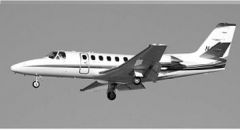
454. What aircraft is pictured above?
A. Citation 550 B. Citation 10 C. Beechjet D. Golden Eagle |
A. Citation 550
(LP 14, p. 52) |
|

455. Which of the following aircraft is depicted in this graphic?
A. C172 B. C208 C. C210 D. C130 |
C. C210
(LP 14, p. 38) |
|
|
456. Which statement is NOT true regarding the general characteristics of Category II aircraft?
A. Large weight class B. They operate at FL240 and below C. Speed is 160-250 knots D. Climb rate is 1,000 to 2,000 feet per minute |
A. Large weight class
(LP 14, p. 6) |
|
|
457. A C17 is included in aircraft Category ___________.
A. I B. II C. III D. IV |
C. III
(LP 14, p. 4) |
|
|
458. Counter control to a wake turbulence induced roll is most effective when _______.
A. there is no more than a 5 knot crosswind B. a large aircraft follows a heavy aircraft C. a rapid descent is made D. the ailerons extend beyond the edge of the vortex |
D. the ailerons extend beyond the edge of the vortex
(LP 13, p.19) |
|
|
459. The effect of the rotating air masses generated behind the wing tips of aircraft or behind the rotor tips of helicopters in forward motion is __________.
A. updrafts and downdrafts B. wake turbulence C. low-level wind shear D. attitude variations |
B. wake turbulence
(LP 13, p. 3) |
|
|
460. The forces that are acting on a helicopter in flight are lift, thrust, _______, and _______.
A. torque, drag B. weight, gravity C. angle of attack, drag D. weight, drag |
D. weight, drag
(LP 12, p. 39) |
|
|
461. With a(n) ________ in airspeed, drag ________.
A. increase; increases rapidly B. increase; decreases rapidly C. decrease; increases rapidly D. decrease; remains the same |
A. increase; increases rapidly (LP 12, p. 14)
|
|
|
462. When air is forced to travel at a faster speed across the top of a wing versus the bottom, this will result in ________ the wing.
A. lower pressure above B. lower pressure below C. higher pressure above D. atmospheric pressure above |
A. lower pressure above
(LP 12, p. 4) |
|
|
463. A pilot flying VFR must maintain at least 5 miles visibility in all or part of class ________ and ________ airspace.
A. E;A B. E;G C. G;D D. C;D |
B. E;G
(LP 11, pp. 16 and 18) |
|
|
464. No person may operate an aircraft under VFR in Class C airspace with a flight visibility of less than ________.
A. 1NM B. 1SM C. 3NM D. 3SM |
D. 3SM
(LP 11, p. 15) |
|
|
465. An ATC specialist who is 41 years of age and works in the Terminal option is required to have a medical examination every ________.
A. year B. 2 years C. 3 years D. 5 years |
A. year
(LP 10, p. 41) |
|
|
466. Which of the following statements is true concerning FAR Part 91 aircraft speed restrictions?
A. Above 10,000 MSL, no aircraft may exceed 250 knots. B. No aircraft may exceed 200 knots in any Class C airspace. C. No aircraft may exceed 200 knots when operating below Class B airspace. D. Under no circumstances may an aircraft exceed 250 knots in Class B airspace. |
C. No aircraft may exceed 200 knots when operating below Class B airspace.
(LP 10, p. 21) |
|
|
467. A(n) ________is specified information, relating to the intended flight of an aircraft.
A. ATC Clearance B. Flight Plan C. Supplement D. Notice |
B. Flight Plan
(LP 10, p. 7) |
|
|
468. ATC does not have the authority or the responsibility to issue clearances in class _____ airspace.
A. C B. D C. E D. G |
D. G
(LP 9, p. 12) |
|
|
469. Recognition features of the B737 are ___________.
A. One jet engine under each wing, low wing B. Two jet engines under each wing, low wing C. One jet engine under each wing, T-tail D. One jet engine under each wing, one jet in tail |
A. One jet engine under each wing, low wing
(LP 14, p. 58) |
|
|
470. What is a prominent identification feature of the BE35?
A. Tricycle gear B. Low-wing C. Propeller-driven D. “V”-tail |
D. “V”-tail
(LP 14, p. 40) |
|
|
471. A civilian aircraft designator __________.
A. is always 4 alpha-numerics B. indicates the mission C. generally indicates the manufacturer D. may be 1 to 4 characters |
C. generally indicates the manufacturer
(LP 14, p. 11) |
|
|
472. _________ is jet engine exhaust.
A. Prop-wash B. Wake turbulence C. Jet blast D. Counter control |
C. Jet blast
(LP 13, p. 24) |
|
|
473. Which of the following statements regarding wingtip vortices is true?
A. They drift inward and sink. B. They drift outward and sink. C. They drift inward and rise. D. They drift outward and rise. |
B. They drift outward and sink. (LP 13, p. 12)
|
|
|
474. The most hazardous aspect of structural icing is _______.
A. decreases weight B. increased drag C. reduced thrust D. airfoil distortion |
D. airfoil distortion
(LP 12, p. 49) |
|
|
475. Which are the primary control surfaces on an airplane?
A. Ailerons, elevator, and flaps B. Elevator, flaps, and trim tabs C. Rudder, ailerons, and elevator D. Flaps, ailerons, and propeller |
C. Rudder, ailerons, and elevator
(LP 12, p. 26) |

